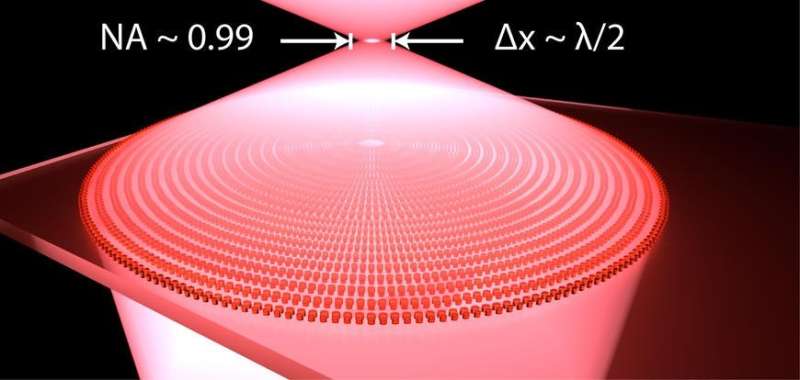March 26, 2018 feature
Metalens achieves near-unity numerical aperture

Researchers have designed an optical lens with the highest free-space numerical aperture to date, achieving a value of just under 1. As the numerical aperture indicates the highest possible resolution that a lens can attain, the new lens can focus light with unprecedented ability, as well as collect light from wide angles. These abilities should make the lens particularly useful for low-light applications, such as single-photon emission, which is often used in quantum optics systems.
The researchers, led by Arseniy Kuznetsov and Ramón Paniagua-Domínguez, at A*STAR (Agency for Science, Technology, and Research) and Nanyang Technological University, both in Singapore, have published a paper on the lens with near-unity numerical aperture in a recent issue of Nano Letters.
Previously, the highest numerical aperture for a free-space lens was 0.95, which corresponds to a maximum collection angle of around 72°. Due to the way these lenses are made, they are also large and expensive, and so cannot be easily scaled down to work with very small systems.
With its numerical aperture of 0.99, the new lens has both a higher resolution and a larger collection angle of 82°. The new lens is made of a metasurface rather than traditional lens materials. The metasurface consists of a pattern of subwavelength-scale structures and has an overall thickness of less than one wavelength of light, resulting in a small size that greatly expands its potential applications.
"High-numerical aperture lenses/microscope objectives are major optical components that are widely used in microscopy, optical detection systems, optical lithography, quantum optics, etc.," Kuznetsov told Phys.org. "Having a high numerical aperture is of primary importance in achieving a high resolution and high detection level of optical signals. Currently existing high-numerical-aperture lenses/microscope objectives are bulky and expensive. In this work, we showed that, using a new concept of metasurfaces based on dielectric nanoantennas, it is possible to design and realize flat optical components that can achieve a numerical aperture higher than all existing optical objectives, using just a device just a few hundred nanometers thick."
To demonstrate the advantages of the new lens, the researchers used it to image nitrogen-vacancy centers in diamond nanocrystals, which are several tens of nanometers in size. The images scanned by the new metalens revealed smaller spots compared to images scanned using commercial lenses with smaller numerical apertures, demonstrating the new lens' higher resolution.
The researchers expect that, in the future, the new lens may also be used to make improvements to photolithography, which is used to produce computer chips and other high-resolution devices. In addition, the new lens' wide-angle collection is expected to increase the efficiency of single-photon emission processes, which are used in quantum optics systems.
"We believe that this new concept will find broad applications in areas where detection of weak optical signals is important," Kuznetsov said. "One example is in quantum optics, which deals with systems containing only single atoms or quantum emitters emitting light at the single-photon level. Such flat lenses not only allow for the detection of weak optical signals, but also can operate at extreme conditions of low temperatures and in vacuum, which is typical for quantum optics experiments.
"Another important application direction could be in wearable and mobile photonic devices, where dense integration of high-efficiency optical components is required. For example, the lenses could find applications in mobile phone cameras and augmented reality glasses."
More information: Ramón Paniagua-Domínguez et al. "A Metalens with a Near-Unity Numerical Aperture." Nano Letters 18, 2124–2132 (2018). DOI: 10.1021/acs.nanolett.8b00368
Journal information: Nano Letters
© 2018 Phys.org





















